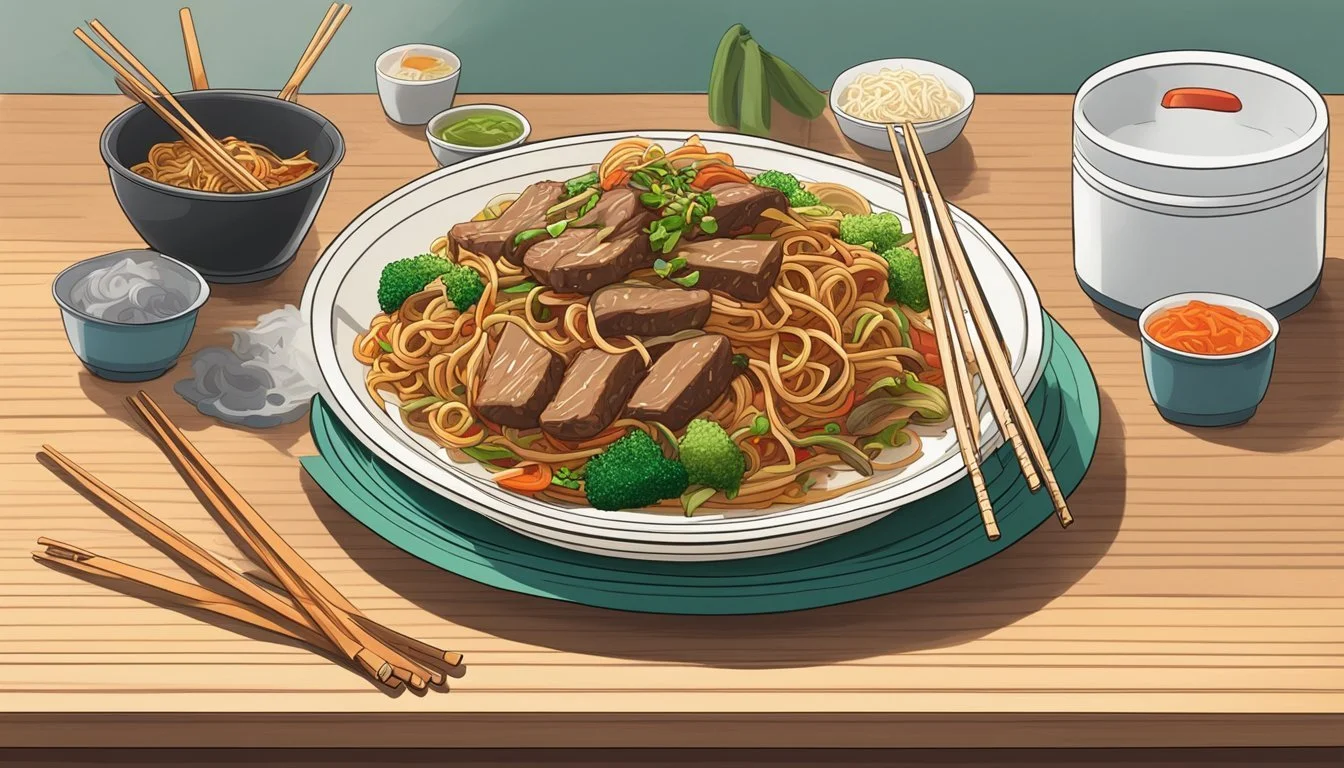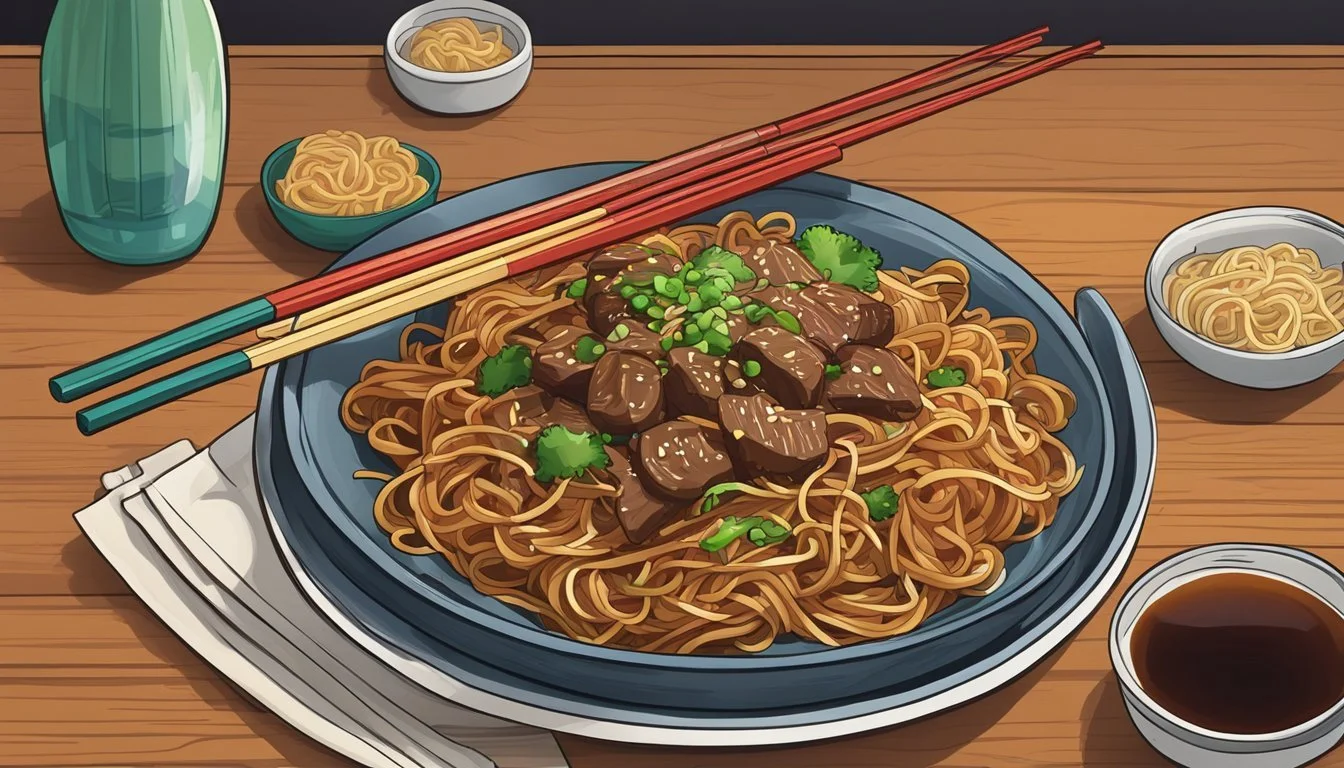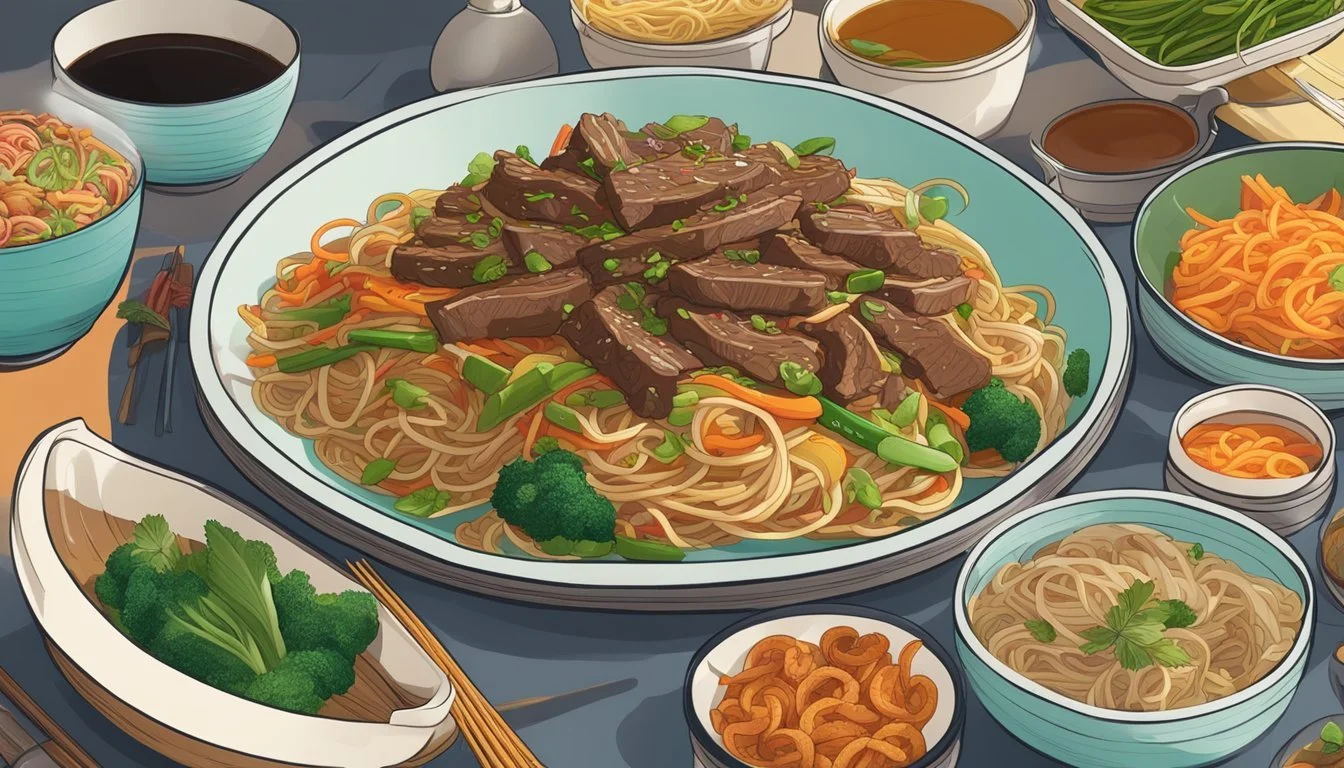How Long Does Beef Lo Mein Last?
Storage Tips and Shelf Life
Craving the rich flavors of beef lo mein? This popular Chinese takeout dish doesn't just tantalize the taste buds; it also raises an important question: how long does beef lo mein last? Stored properly in the refrigerator at 32°F to 40°F, beef lo mein typically lasts for 3-4 days. This ensures maximum freshness and safety when enjoying any leftovers.
Preparing beef lo mein at home using restaurant-inspired recipes can yield mouth-watering results. After searing beef to the perfect tenderness and stir-frying with vegetables and savory sauces, it's essential to allow the dish to cool completely before storing it. This practice helps to maintain the integrity of the ingredients and keeps the meal enjoyable.
Thinking about freezing your beef lo mein? Freezing the dish at 0°F (-18°C) can extend its shelf life up to three months. Using airtight containers or freezer bags is crucial to prevent freezer burn and preserve its delectable quality. So whether you're planning to enjoy your meal right away or save some for later, understanding how to store beef lo mein can help you savor every bite.
Understanding Beef Lo Mein
Beef lo mein is a classic Chinese dish that combines tender beef with lo mein noodles and a variety of vegetables, all tossed in a savory sauce. Key components include the noodles, the beef, a medley of vegetables, and a rich lo mein sauce.
Defining Lo Mein
Lo Mein Noodles: Lo mein noodles are a type of Chinese egg noodle, typically thicker than other varieties like chow mein. They have a smooth texture and are known for their ability to hold sauces well. Cooking involves boiling until tender, then stir-frying with other ingredients.
Beef: Beef in lo mein is often sliced thin and marinated to enhance flavor and tenderness. Common cuts include flank steak or sirloin. The beef is usually seared quickly at high heat to retain its juices.
Vegetables: Aromatic and colorful vegetables, such as bell peppers, carrots, napa cabbage, and mushrooms, are staple ingredients. They are stir-fried briefly to maintain crispness and bright color, adding both nutrition and texture to the dish.
Lo Mein Sauce: The sauce typically comprises soy sauce, oyster sauce, and sometimes hoisin sauce. It provides the savory, umami-rich flavor profile that characterizes lo mein. Sesame oil and garlic may also be included for depth of flavor.
Stir Fry Method: Cooking involves heating oil in a wok or skillet, followed by quickly stir-frying the beef and vegetables. Noodles and sauce are then added and tossed together until evenly coated and heated through. This method ensures the dish is flavorful and well-mixed.
Crucial Ingredients and Substitutes
To perfect the taste and texture of beef lo mein, it's important to select the right ingredients and know suitable alternatives. The primary focus is on the main components, the protein, vegetables, and the sauce that ties everything together.
Main Ingredients
Essential ingredients for beef lo mein include lo mein noodles, soy sauce, sesame oil, oyster sauce, and hoisin sauce.
Lo mein noodles are typically thicker and chewier, providing a satisfying base for the dish. If unavailable, spaghetti or linguine can be used as substitutes.
Soy sauce adds a salty flavor, while oyster sauce imparts a hint of sweetness and umami.
Sesame oil provides a nutty aroma.
Hoisin sauce contributes a slightly sweet and tangy taste.
Protein Variations
Beef is traditionally used in lo mein for its rich flavor. The recommended cuts include flank steak or sirloin, sliced thinly against the grain to enhance tenderness.
Alternative proteins can be used effectively. Chicken breast or thighs offer a leaner option, while shrimp adds a seafood twist. For a vegetarian version, tofu works well when pressed and cubed.
Vegetable Additions
A mix of vegetables enhances the flavor and nutritional value of beef lo mein. Common additions include carrots, onions, garlic, mushrooms, snow peas, green onions, broccoli, cabbage, and peppers.
Carrots add sweetness and color when julienned.
Broccoli and cabbage provide a crunchy texture.
Mushrooms and peppers enhance the savory profiles.
Garlic and green onions boost the aromatic experience.
Each vegetable should be sliced uniformly to ensure even cooking.
Sauce Composition
The sauce is a critical aspect of beef lo mein, combining soy sauce, oyster sauce, hoisin sauce, and sesame oil.
Soy sauce forms the salty foundation.
Oyster sauce contributes a rich umami.
Hoisin sauce provides sweetness with depth.
A dash of sesame oil finishes the sauce, imparting a nutty fragrance.
For additional flavor, some recipes include a splash of rice vinegar for acidity or a pinch of sugar to balance the savory elements. Adjusting the quantities allows customization based on personal taste preferences.
Preparing Beef Lo Mein
Preparing Beef Lo Mein involves proper cooking instructions, achieving the right texture, and using effective tossing techniques to ensure the flavors are well blended.
Cooking Instructions
Start by preparing all ingredients. Slice the beef thinly and marinate it with soy sauce and cornstarch for at least 15 minutes. Heat oil in a large skillet or wok over medium-high heat. Add the beef and cook until it is seared and browned but still tender, about 3-4 minutes. Remove the beef and set it aside.
In the same wok, add more oil if needed and stir-fry the garlic, ginger, and white parts of the scallions until fragrant. This typically takes around 30 seconds. Then, add vegetables like carrots, bell peppers, mushrooms, and Napa cabbage, cooking them until they are tender but still crisp.
Once the vegetables are ready, return the beef to the wok. Add cooked lo mein noodles, ensuring they are boiled to an al dente texture beforehand. Pour in the sauce, usually made of soy sauce, hoisin, and Shaoxing wine, and stir everything together until well-mixed.
Achieving the Perfect Texture
Achieving the perfect texture for Beef Lo Mein requires attention to the cooking time of both the noodles and the beef. The noodles should be boiled until al dente, meaning firm to the bite. Overcooked noodles can become mushy, while undercooked ones will be too hard, affecting the dish's quality.
To maintain a tender texture, beef slices should be seared quickly at high heat, ensuring they are brown on the outside but still juicy inside. Using fresh, crisp vegetables adds a contrasting crunch that complements the noodles and beef well. Proper stir-frying techniques ensure that the textures of all ingredients are preserved and enhanced.
Tossing Techniques
Tossing the ingredients properly helps to distribute the flavors evenly throughout the Beef Lo Mein. Start by evenly spreading the noodles in the wok, then use a pair of tongs or chopsticks to gently lift and turn them, mixing them with the other ingredients.
This method prevents clumping and ensures that every bite has a consistent taste. When adding the sauce, drizzle it around the perimeter of the wok. As the sauce heats, it will become more fragrant, and covering all the ingredients with it will enhance the overall flavor.
Continue tossing lightly but thoroughly, ensuring all components are well combined without breaking the noodles or overcooking the vegetables. This technique is essential for a well-balanced and flavorful Beef Lo Mein.
Storage Guidelines
Proper storage of beef lo mein is essential to maintain its freshness and prevent spoilage. Below are the guidelines for refrigeration, freezing, and recognizing signs of spoilage to ensure food safety.
Refrigeration
Beef lo mein should be stored in the refrigerator at temperatures between 32°F and 40°F. Refrigeration slows down bacterial growth, extending the shelf life to about 3-5 days.
Cool the dish completely before refrigerating. Use airtight containers to prevent moisture loss and contamination. Label the containers with the storage date to keep track of freshness. Avoid overfilling the refrigerator as this can affect air circulation and cooling efficiency.
Freezing Methods
For longer storage, beef lo mein can be frozen. Freezing dramatically slows bacterial growth, allowing the dish to be stored for up to 2 months.
Cool the lo mein to room temperature before freezing. Place the dish in airtight containers or freezer bags to prevent freezer burn. Remove as much air as possible from the bags. Label the bags with the date of freezing. To thaw, transfer the dish to the refrigerator and allow it to defrost overnight.
Recognizing Spoilage
Identifying spoilage in beef lo mein is crucial to prevent foodborne illnesses. Signs of spoilage include a sour or pungent odor, changes in color, and a slimy texture.
Bacterial growth can multiply rapidly in warm environments, so always heed these warnings. If any of these signs are present, discard the dish immediately. Ensure to check leftovers regularly to maintain food safety.
Safety and Freshness
Maintaining safety and freshness in beef lo mein involves understanding optimal storage conditions and taking steps to prevent bacterial growth. These measures are crucial to ensure the dish remains safe to eat for as long as possible.
Optimal Storage Conditions
Beef lo mein needs to be stored correctly to maximize its shelf life and maintain its flavor. Refrigeration is key; store the dish in an airtight container to prevent air exposure.
Ideally, beef lo mein should be kept at or below 40°F (4°C) in the fridge. This helps slow down bacterial growth and keeps the food fresh for 3 to 5 days. If you need to store it longer, freezing is an option. For freezing, once the beef lo mein has cooled to room temperature, transfer it into airtight containers or freezer-safe bags. Label these with the date for accurate tracking. When frozen properly, beef lo mein can last up to 2 months.
Preventing Bacterial Growth
Preventing bacterial growth is essential to keep beef lo mein safe. Bacteria can proliferate rapidly at room temperature, leading to spoilage and potential foodborne illness. To mitigate this risk:
Cool the lo mein quickly after cooking. Leaving it at room temperature for too long can promote bacterial growth.
Use airtight containers to block out air and moisture that can lead to a slimy texture and spoilage.
Always refrigerate leftovers promptly. Avoid leaving the dish out for more than 2 hours after cooking.
Before consuming, check for signs of spoilage such as unusual odor, color change, or a slimy texture. If any of these are present, discard the food immediately to ensure safety.
Reheating Beef Lo Mein
Proper reheating ensures that leftovers like beef lo mein retain their texture and flavor. Both the microwave and stovetop methods have effective techniques to achieve this.
Microwave Method
Using a microwave is a quick and convenient way to reheat beef lo mein.
Container Preparation: Place the beef lo mein in a microwave-safe container. This prevents any harmful chemicals from contaminating the food.
Moisture: Drizzle a small amount of water or broth over the noodles to keep them from drying out. This step is crucial for maintaining the dish's texture.
Covering: Cover the container loosely with plastic wrap or a microwave-safe lid, leaving a small opening for steam to escape. This helps evenly distribute heat without causing a rubbery texture.
Heating: Microwave on high for 1-2 minutes. Stir the lo mein halfway through to ensure even heating. Repeat if necessary until heated through.
Microwaving beef lo mein properly can make leftovers taste almost as good as freshly cooked.
Stovetop Technique
Reheating beef lo mein on the stovetop offers excellent control over the texture and flavor.
Pan Preparation: Heat a skillet or wok over medium heat and add a small amount of oil such as vegetable or sesame oil. This prevents the noodles from sticking and adds a touch of flavor.
Cooking: Add the beef lo mein to the hot oil, tossing to coat the noodles evenly. This method keeps the noodles from becoming mushy and ensures they are thoroughly heated.
Steaming: Cover the pan with a lid for a few minutes. This allows the steam to heat the lo mein thoroughly without drying it out.
Stir-Fry Touch: Stir-fry for an additional 2-3 minutes if desired, adjusting seasonings like soy sauce or chili oil to taste.
Using the stovetop technique enhances the dish's flavor and texture, making it a preferred method for many.
Customization Tips
There are several ways to customize beef lo mein, including making it vegetarian or adjusting the spice level. Below are specific tips on adapting this dish to suit different dietary preferences and heat tolerances.
Vegetarian Adaptations
Vegetarian adaptations to beef lo mein are straightforward. Substitute beef with tofu, which absorbs flavors well. Opt for firm tofu for the best texture. Another protein-rich option is tempeh, offering a slightly nutty flavor.
Replace beef broth with vegetable broth to maintain a rich taste. Use egg noodles or, for those needing gluten-free options, rice noodles or gluten-free noodles work well. Add more vegetables like bell peppers, snap peas, and mushrooms to boost flavor and nutrition.
Hoisin sauce and soy sauce have strong umami flavors, so ensure these vegetarian-friendly sauces are used to maintain the dish's savory profile.
Spice Level Adjustments
Adjusting the spice level in beef lo mein allows for personalization. For a mild version, reduce or omit chili-based ingredients. Use only a small amount of fresh ginger or opt for sweet bell peppers to add flavor without heat.
To add spice, incorporate hot sauce, chili paste, or sliced fresh chilies. Sriracha or Sambal Oelek can be mixed into the sauce for a consistent heat level throughout the dish. Experiment with a dash of cayenne pepper for a slow-building spice, or add crushed red pepper flakes during cooking for extra kick.
Finishing the dish with chili oil drizzled on top can also elevate the spice without altering the base recipe significantly.
Alternatives and Related Dishes
For those exploring different options and variations, beef lo mein can easily be substituted with other noodle types or proteins. These alternatives allow for adjustments based on dietary preferences and available ingredients.
Related Noodle Varieties
Chow mein is a classic substitute for lo mein, offering a slightly different texture due to the frying process. These noodles are typically crispier, adding a delightful contrast to the dish. Another option is using spaghetti noodles, which can be an accessible alternative in many kitchens. It provides a similar bite and works well with traditional lo mein sauces.
Cantonese-style noodles offer another variation, often thinner and used in a wide range of dishes. These noodles absorb sauces well, making them an excellent choice for robust lo mein preparations.
Beyond Beef: Other Proteins
Chicken lo mein is a popular alternative for those seeking a leaner meat option. The chicken can be marinated similarly to beef, ensuring the flavors are well absorbed. Pork is another versatile option, offering a rich taste that marries well with the sauce.
For seafood lovers, shrimp lo mein provides a light and flavorful protein alternative. The shrimp cooks quickly, making it a great addition for fast meals.
Tofu offers a vegetarian and vegan-friendly option, absorbing flavors from the sauce while providing a satisfying texture. It is a perfect choice for those looking to reduce or eliminate meat consumption without sacrificing taste.







